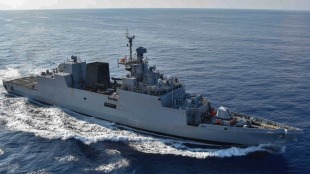Корвет «Кілтан» (P30)
Основна інформація
Головні розміри
Машина
- 4 * Pielstick 12PA 6 STC6 Diesel engines
Персонал
Бойові сили та засоби
- Revati Central Acquisition Radar
- EL/M-2221 STGR fire-control radar
- BEL Shikari
- BEL RAWL02 (Signaal LW08) antenna communication grid — Gigabit Ethernet-based integrated ship borne data network, with a fiber optic cable backbone running through the vessel
- NPOL HUMSA (Hull Mounted Sonar Array)
- Bomber Electronic warfare (EW) suites — BEL Ajanta
- Kavach naval decoy system
- 1 * 76.2 mm Oto Super Rapid Gun Mount (SRGM)
- 2 * AK-630M CIWS
- 2 * RBU-6000 (IRL) anti-submarine rocket launcher
- 2*3 Torpedo tubes
- 1 * Ka-28PL or HAL Dhruv
INS Kiltan (P30) is an anti-submarine warfare corvette of the Indian Navy built under Project 28. It is the third of four Kamorta-class corvettes under various stages of induction with the Indian Navy. The ship was built by the Garden Reach Shipbuilders and Engineers (GRSE), Kolkata, launched on 26 March 2013, and commissioned on 16 October 2017. Kiltan represents a leap forward in the Navy's attempts at localisation with as much as 90% of its content drawn from India itself.
The keel of Kiltan was laid in August 2010 and it was launched in Kolkata on 26 March 2013 by Chitra Joshi, wife of Admiral D. K. Joshi, the Chief of Naval Staff. The ship cost an estimated ₹1,700 crores. The ship takes its name from the Kiltan Island, a coral island that is part of India's archipelagic Union Territory of Lakshadweep. It is the successor ship to the INS Kiltan, which was an Arnala-class corvette which participated in Operation Trident, and was later decommissioned in 1987.
Kiltan was handed over to the Navy by the GRSE on 14 October 2017, and was commissioned into the Navy’s Eastern Naval Command in Visakhapatnam on 16 October 2017, in the presence of Indian Defence Minister Nirmala Sitharaman and Navy chief Admiral Sunil Lanba.
The Kamorta-class has been designed by the Indian Navy’s Directorate of Naval Design as part of Project 28. It is capable of fighting under nuclear, biological and chemical environments. It will be a frontline warship of the Indian Navy with advanced stealth features and a low radar signature that enhances its anti-submarine warfare capability. The ship will have a complement of 17 officers and 106 sailors.
Kiltan is India's first ship to have a superstructure of carbon fibre composite material that has been integrated with its main hull, resulting in lower top weight and maintenance costs and improved stealth features. GRSE thus became the first defence shipyard in India to successfully fuse the carbon composite superstructure with the hull. The ship is 109 m (358 ft) long and 12.8 m (42 ft) broad and is highly maneuverable with a top speed of 25 knots (46 km/h; 29 mph). It has a displacement of 3,250 tonnes and a range of about 3,450 nautical miles (6,390 km; 3,970 mi) at 18 knots (33 km/h; 21 mph). It is powered by 4 diesel engines that generate a combined power of 3,000 kW (4,000 hp) and propelled by a main unit of four 3,888 kW (5,214 hp) diesel engines at 1,050 rpm.
Kiltan is to be armed with a range of Indian developed cutting-edge weapons and sensors including «a medium-range gun, torpedo tube launchers, rocket launchers and a close-in weapon system». The ship will also contain an integrated communication system and an electronic warfare system.
- Коментарі
 uk
uk en
en ru
ru


 Військово-морські сили Індії
Військово-морські сили Індії